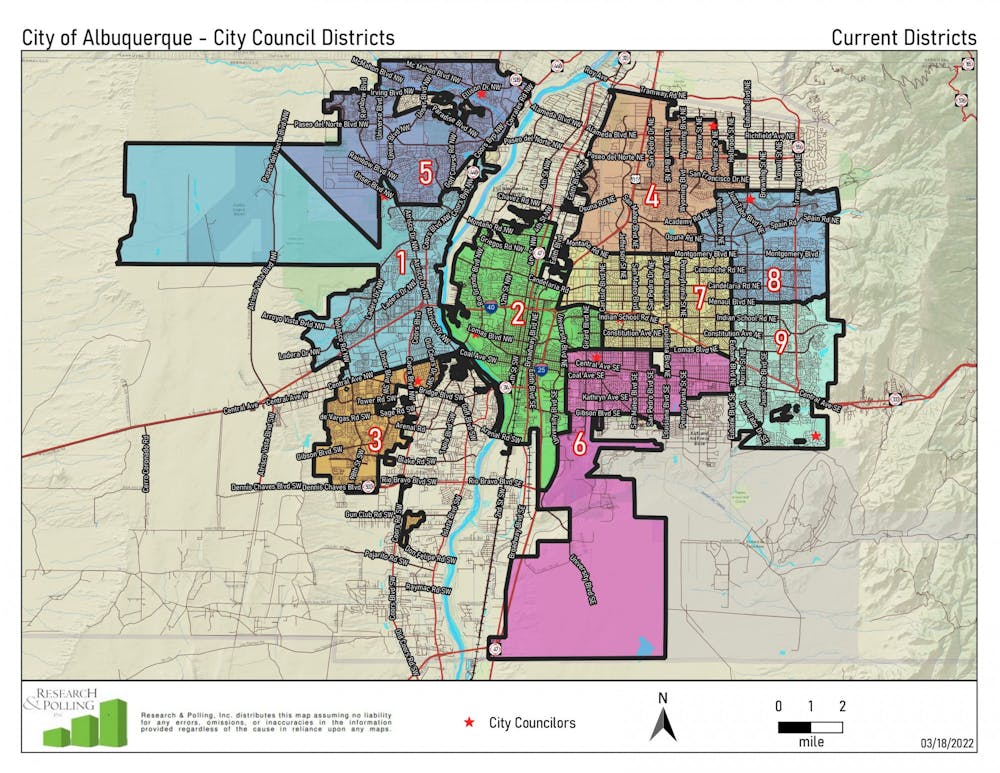The evening of Wednesday, June 8 saw Albuquerque’s redistricting committee meet for their penultimate meeting, continuing the redistricting process for the city. Members voted in favor of 2 new maps for consideration, one of which being an updated version of citizen map 3, along with what voting method they will use on maps at the next meeting.
The “fairness for our future” map, which was adopted as citizen map 5, was presented by Keith Sánchez, a teacher and Ph.D. candidate in UNM’s Chicana and Chicano studies program. The map aims to support the west side of the city by adding 2 additional representatives and includes 4 Hispanic-majority districts.
“I simply feel (it) is vital that the west side obtain equitable representation in the city, primarily because, without a representative voice at the table, policy decisions can adversely affect our kids and I’ve seen it — their families — the majority of whom stem from one of the lowest socioeconomic and most vulnerable populations in our city. This concept map, I feel, brings the opportunity for much-needed resources to the west side,” Sánchez said.
In their original form, the current districts consisted of 3 Hispanic-majority districts. This number is now down to 2 due to voting-age population changes in District 2. In order to create a fourth Hispanic-majority district, Citizen Map 5 has District 6 stretch from the International District across to Berelas and into the southwestern part of the city; however all maps, except for concept map D, feature 7 majority-minority districts, according to Brittany Poss, director of data and analytics at Research and Polling, Inc..
“Thank you for acknowledging minority-majority districts how you’ve currently drawn them up. As a Hispanic male, I don't lump myself in with all minorities. I’m not trying to be disparaging here, but I know other groups feel the same way. You know, they are separate groups even though, oftentimes, we view them through one lens,” committee member Joaquin Baca said.
Baca voiced his concern over the lack of a fourth Hispanic-majority district in many of the maps, as a fourth Hispanic-majority district would make the districts more proportional to population levels in the city. The dispersion of the Hispanic population makes it hard to create a fourth district, though, in ways other than how it is done in citizen map 5, according to Poss.
Baca ultimately favored citizen map 5 because of the fourth Hispanic-majority district despite the lack of compactness, as he believes the Hispanic population will continue to grow in Albuquerque which could account for this issue. There are still concerns over the dilution of Hispanic voters in the Northeast Heights, though.
After a request from Committee Chair Cathryn McGill, the demographics of voting-age Black and Asian residents were laid across citizen map 5. District 4 has the highest Asian population at 6.1% with the rest varying from 1.2% to 4.6%. All of the districts have a black population between 2% and 4.4%. Six of the nine districts have a Native American population of around 4% with the highest of the remaining 3 districts being 6% and the lowest at 2.6%.
Committee member Keith Romero spoke in support of citizen map 5, saying that it has Councilor Isaac Benton’s support even though the map would displace Benton, causing him to lose his incumbency status; Romero said Benton believes the map is for the greater good of the city.
“(The west side is) in such dire need of resources and representation and … a conversation concerning what the numbers bear out in terms of Hispanic population and other groups within the city. I think that this map lines up well along those constitutional mandates. Again, there are going to be sacrifices that have to be made with what we're tasked with, so I'm in support of this map,” Romero said.
An updated version of citizen map 4, a historic community of interest map, was presented by community member Merideth Paxton. The changes made to it include 2 precincts moving from District 2 to District 1, District 2 does not go south of Central Ave. and District 4 does not enter the North Valley.
“Citizen map 4, the historic community of interest map, is a more horizontally oriented version of the concept A map. During the council redistricting that followed the 2010 census, the importance of the community of interest in the core of the city was emphasized. The area shows where we came from and who we are,” Paxton said.
Get content from The Daily Lobo delivered to your inbox
The committee also agreed on a rank-choice voting system in which each member will be able to vote on a 5-point scale whether they strongly recommend, recommend, are neutral to, do not recommend or strongly do not recommend each map at the next meeting.
“I think it lets us give a more nuanced recommendation between maps and get points for multiple maps and then also focus in on individual maps when we review them,” Vice-Chair Travis Kellerman said.
The vote will be used to determine which maps they submit to the City Council for consideration, although the City Council does not have to choose any maps the committee submits. The committee will meet next on Wednesday, June 29 at 5:30 p.m. via Zoom for final deliberations and voting. Members of the public can join the Zoom meeting or watch on YouTube.
Madeline Pukite is the managing editor at the Daily Lobo. They can be contacted at news@dailylobo.com or on Twitter @maddogpukite.






